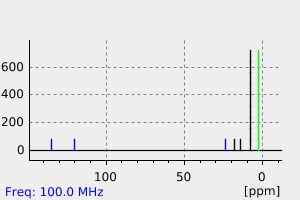(E)-4(R)-(triethylsilyl)-2-pentene | 103981-02-8
中文名称
——
中文别名
——
英文名称
(E)-4(R)-(triethylsilyl)-2-pentene
英文别名
trans-4-triethylsilyl-2-pentene;(E)-4(S)-(triethylsilyl)-2-pentene;triethyl-[(E)-pent-3-en-2-yl]silane
CAS
103981-02-8
化学式
C11H24Si
mdl
——
分子量
184.397
InChiKey
BJRWWFRMJWSXMY-UXBLZVDNSA-N
BEILSTEIN
——
EINECS
——
-
物化性质
-
计算性质
-
ADMET
-
安全信息
-
SDS
-
制备方法与用途
-
上下游信息
-
文献信息
-
表征谱图
-
同类化合物
-
相关功能分类
-
相关结构分类
计算性质
-
辛醇/水分配系数(LogP):4.46
-
重原子数:12
-
可旋转键数:5
-
环数:0.0
-
sp3杂化的碳原子比例:0.82
-
拓扑面积:0
-
氢给体数:0
-
氢受体数:0
反应信息
-
作为反应物:描述:特戊醛 、 (E)-4(R)-(triethylsilyl)-2-pentene 在 四氯化钛 作用下, 以 二氯甲烷 为溶剂, 反应 3.0h, 以20%的产率得到(E)-(3R,4S)-2,2,4-trimethyl-5-hepten-3-ol参考文献:名称:Asymmetric synthesis catalyzed by chiral ferrocenylphosphine-transition metal complexes. 3. Preparation of optically active allylsilanes by palladium-catalyzed asymmetric Grignard cross-coupling摘要:DOI:10.1021/jo00370a006
-
作为产物:描述:参考文献:名称:Photo-Induced Chromiumcarbonyl Catalyzed Hydrosilylation of Conjugated Dienes with Triethylsilane: The Solvent Effect摘要:共轭二烯(1,3-丁二烯,2-甲基-1,3-丁二烯,2,3-二甲基-1,3-丁二烯,反式-1,3-戊二烯)与三乙基硅烷的光催化氢硅烷化反应,使用Cr(CO)5L(L = CO,P(CH3)3,P(OCH3)3,P(C6H5)3,P(C6H11)3,NC5H5)在两种非常不同的溶剂甲苯和四氢呋喃中进行研究,以与在正己烷中发现的结果进行比较。在甲苯中,光催化氢硅烷化产物与正己烷中的产物相同,唯一的例外是反式-1,3-戊二烯,它产生顺式-1-三乙基硅基-2-戊烯作为唯一产物。然而,在甲苯和正己烷中,每个前体配合物显示不同的催化活性。在甲苯中,1,3-丁二烯的氢硅烷化反应通常比正己烷中的快得多。在甲苯中使用Cr(CO)6,Cr(CO)5[P(CH3)3]或Cr(CO)5[P(OCH3)3],随着反应的进行,三乙基硅烷的转化几乎呈线性增加,表明活性催化剂在整个反应过程中保持稳定,类似于正己烷中的情况。虽然在正己烷中无法使用Cr(CO)5[P(C6H5)3]或Cr(CO)5(NC5H5)实现1,3-丁二烯的氢硅烷化,但相同的前体配合物似乎在甲苯中是活跃的,尽管与使用Cr(CO)5[P(CH3)3]或Cr(CO)5[P(OCH3)3]获得的转化速率相比,转化速率要低得多。前体配合物Cr(CO)5[P(C6H11)3]在甲苯中和正己烷中均不显示催化活性。在四氢呋喃中,使用任何前体配合物都无法观察到1,3-丁二烯与三乙基硅烷的光催化氢硅烷化反应。通过在甲苯中使用Cr(CO)5[P(OCH3)3]作为催化剂,研究了共轭二烯在氢硅烷化中的相对反应性,得到与正己烷溶液中相同的反应性顺序:1,3-丁二烯 > 3-甲基-1,3-丁二烯 > 2,3-二甲基-1,3-丁二烯 > 反式-1,3-戊二烯。对于所有二烯烃,在甲苯中的氢硅烷化产物转化率均高于在正己烷中。DOI:10.1515/znb-2003-0707
文献信息
-
Photocatalytic hydrosilylation of conjugated dienes with triethylsilane in the presence of Cr(CO)5L (L = CO, P(CH3)3, P(OCH3)3)作者:Saim Özkar、Vagif M. Akhmedov、Ceyhan KayranDOI:10.1016/s0022-328x(96)06843-x日期:1997.4The effect of donor ligands on the chromium carbonyl photocatalysed hydrosilylation of 1,3-butadiene, 2-methyl-1,3-butadiene, 2,3-dimethyl-1,3-butadiene, trans-1,3-pentadiene with triethylsilane was studied. Photocatalytic hydrosilylation of dienes conducted in the presence of Cr(CO)(5)L (L = P(CH3)(3) or P(OCH3)(3)) yields the cis-1,4-adducts, 1-triethylsilyl-2-butene derivatives, as the main products; these have been isolated by distillation or preparative GC and fully characterised by NMR spectroscopy. As with the photocatalytic hydrosilylation of dienes in the presence of Cr(CO)(6), we propose a mechanism which involves the initial conversion of Cr(CO)(5)L into fac-Cr(CO)(3)L(eta(4)-1,3-diene) followed by a further photolytic CO substitution by triethylsilane, forming a Cr(CO)(2)(H)(SiEt3)L(eta(4)-1,3-diene)intermediate. The addition of hydride to diene occurs reversibly to form an eta(3)-enyl ligand prior to the irreversible silyl transfer to the organic moiety. The 1,4-hydrosilylation adduct is then replaced by new substrates to complete the catalytic cycle. Cr(CO)SL complexes form active species which are much more stable than the one generated from CI(CO), in the absence of any donor ligands. Thus, introduction of an equimolar amount of donor ligand (trimethylphosphine or trimethylphosphite) increases the Life of the catalyst. This leads to the achievement of larger turn-over numbers (80 or 70) compared with the value of 30 for just Cr(CO)(6). Cr(CO)(5)L (L = P(C6H5)(3), P(C6H11)(3) or C5H5N) proved inactive in the attempted photocatalytic hydrosilylation of dienes.
表征谱图
-
氢谱1HNMR
-
质谱MS
-
碳谱13CNMR
-
红外IR
-
拉曼Raman
-
峰位数据
-
峰位匹配
-
表征信息
同类化合物
(2-溴乙氧基)-特丁基二甲基硅烷
鲸蜡基聚二甲基硅氧烷
骨化醇杂质DCP
马沙骨化醇中间体
马来酸双(三甲硅烷)酯
顺式-二氯二(二甲基硒醚)铂(II)
顺-N-(1-(2-乙氧基乙基)-3-甲基-4-哌啶基)-N-苯基苯酰胺
降钙素杂质13
降冰片烯基乙基三甲氧基硅烷
降冰片烯基乙基-POSS
间-氨基苯基三甲氧基硅烷
镓,二(1,1-二甲基乙基)甲基-
镁,氯[[二甲基(1-甲基乙氧基)甲硅烷基]甲基]-
锑,二溴三丁基-
铷,[三(三甲基甲硅烷基)甲基]-
铂(0)-1,3-二乙烯-1,1,3,3-四甲基二硅氧烷
钾(4-{[二甲基(2-甲基-2-丙基)硅烷基]氧基}-1-丁炔-1-基)(三氟)硼酸酯(1-)
金刚烷基乙基三氯硅烷
酰氧基丙基双封头
达格列净杂质
辛醛,8-[[(1,1-二甲基乙基)二甲基甲硅烷基]氧代]-
辛甲基-1,4-二氧杂-2,3,5,6-四硅杂环己烷
辛基铵甲烷砷酸盐
辛基衍生化硅胶(C8)ZORBAX?LP100/40C8
辛基硅三醇
辛基甲基二乙氧基硅烷
辛基三甲氧基硅烷
辛基三氯硅烷
辛基(三苯基)硅烷
辛乙基三硅氧烷
路易氏剂-3
路易氏剂-2
路易士剂
试剂Cyanomethyl[3-(trimethoxysilyl)propyl]trithiocarbonate
试剂3-[Tris(trimethylsiloxy)silyl]propylvinylcarbamate
试剂3-(Trimethoxysilyl)propylvinylcarbamate
试剂2-(Trimethylsilyl)cyclopent-2-en-1-one
试剂11-Azidoundecyltriethoxysilane
西甲硅油杂质14
衣康酸二(三甲基硅基)酯
苯胺,4-[2-(三乙氧基甲硅烷基)乙基]-
苯磺酸,羟基-,盐,单钠聚合甲醛,1,3,5-三嗪-2,4,6-三胺和脲
苯甲醇,a-[(三苯代甲硅烷基)甲基]-
苯并磷杂硅杂英,5,10-二氢-10,10-二甲基-5-苯基-
苯基二甲基氯硅烷
苯基二甲基乙氧基硅
苯基二甲基(2'-甲氧基乙氧基)硅烷
苯基乙酰氧基三甲基硅烷
苯基三辛基硅烷
苯基三甲氧基硅烷







